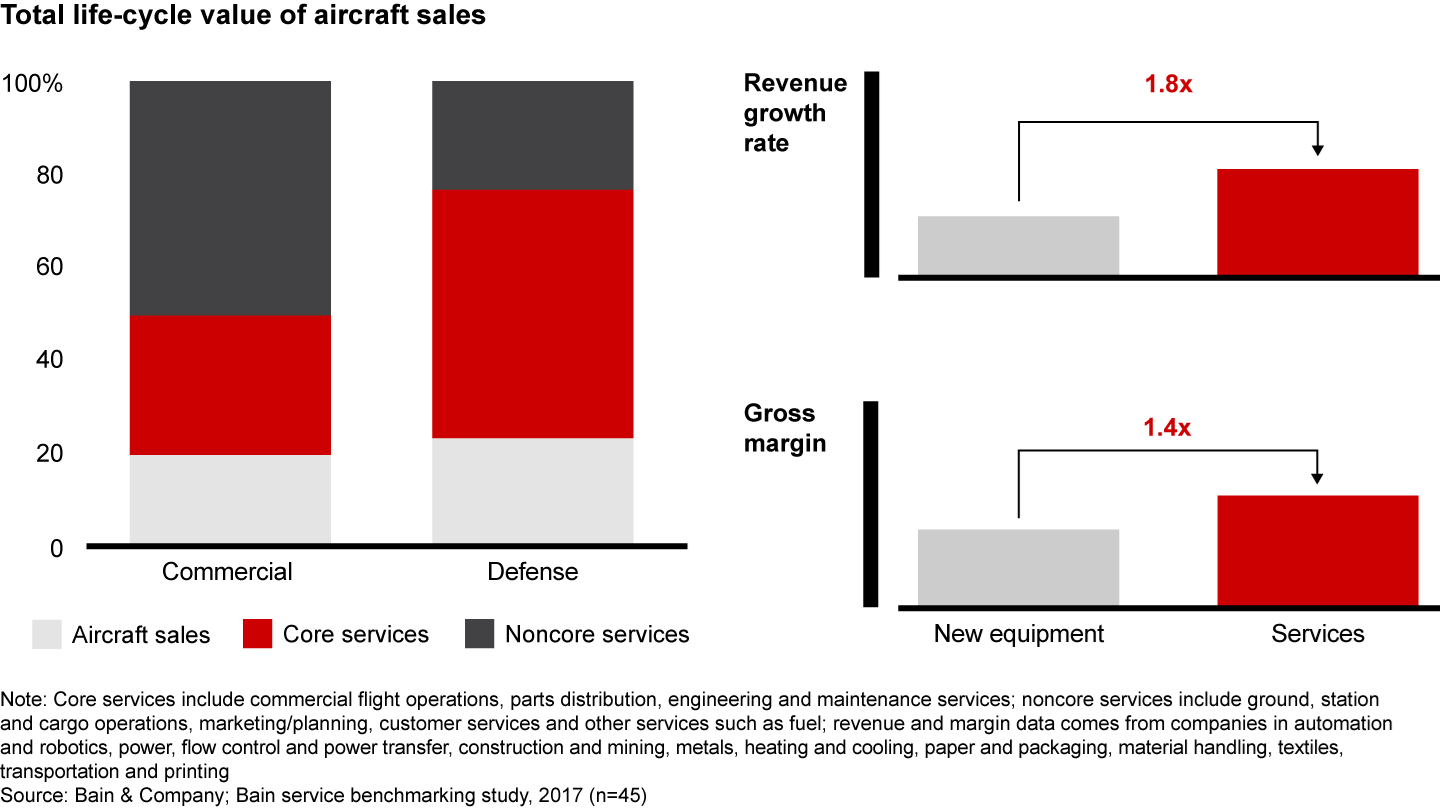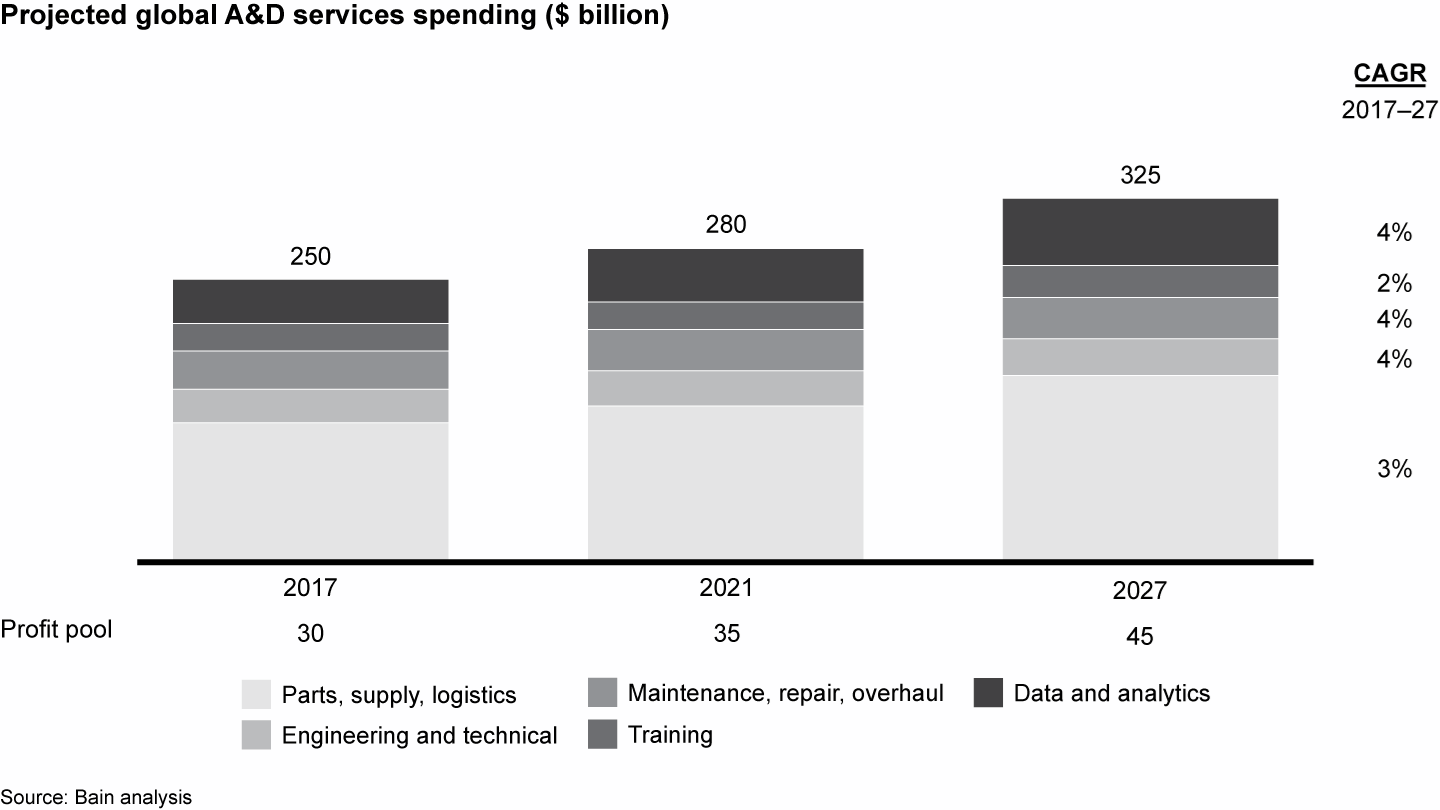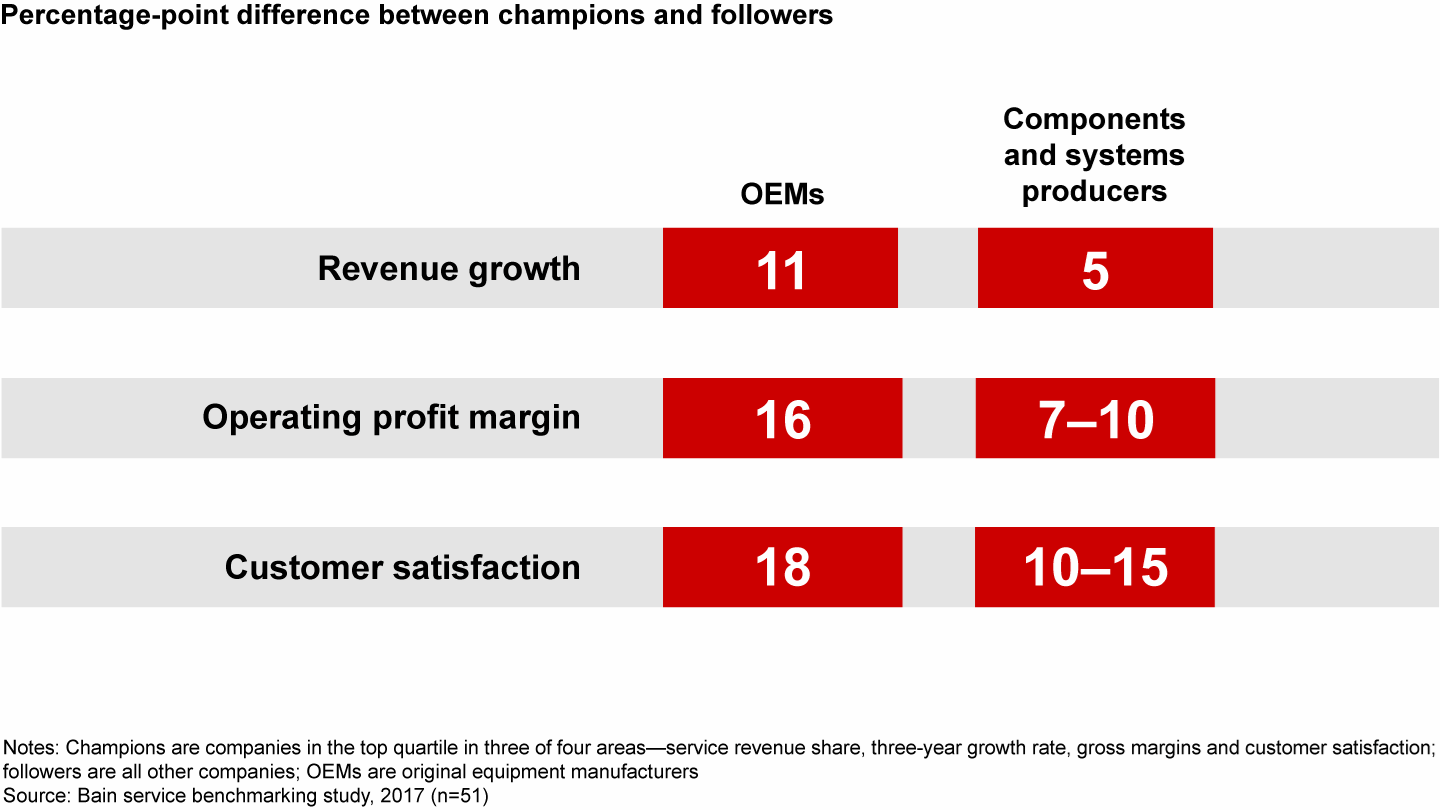Brief

In evidenza
- Despite the higher margins and strong demand for aftermarket services, many original equipment manufacturers in aerospace and defense have been relatively slow to grow their services business.
- Deep-seated manufacturing practices are part of the challenge. A&D manufacturers have slower decision making, higher costs and a legacy of running services and original equipment businesses together.
- Top service performers, by contrast, give services their own business and an operating model tailored for the aftermarket.
- These outperformers also build a repeatable model by designing easily serviceable equipment and standardizing service offerings.
The lure of aftermarket services has tantalized aerospace and defense (A&D) manufacturers for years, frustrating many of these firms that have been trying to expand their services business without making much headway. Done right, services such as maintenance, parts distribution, logistics and personnel training hold tremendous promise. They represent nearly 80% of the life-cycle value of an aircraft sale, as well as gross margins that are 1.4 times that of new equipment, we estimate (see Figure 1). Well-executed services also deepen customer loyalty by providing more frequent and different ways to touch customers over the years they use equipment.
Aftermarket services for aerospace and defense companies promise a larger market and better economics than new equipment


Demand for A&D services is strong, for several reasons. Greater scrutiny of costs has extended the service life of fleets and favors upgrades over new products. Outcomes-based contracts have gained popularity, prompting consolidated buying across the value chain. The proliferation of digital data from sensor-enabled equipment and other sources has created new service opportunities.
As a result, we expect that from 2017 to 2027, services will add roughly $15 billion to the global industry profit pool, which will reach $45 billion (see Figure 2).
Demand should remain strong for aerospace and defense services


Many original equipment manufacturers (OEMs) have aggressive targets to increase their services revenue considerably. Boeing, Airbus and Embraer aim to increase their 2017 service revenues as much as three times within 10 years. Tier I and II suppliers like Honeywell are expanding life-cycle offerings such as by-the-hour services. Airlines are doing more of their own repairs. Traditional service providers such as CAE have expanded the breadth of offerings and targeted select offerings to grow their market share.
Yet in this virtual dogfight to dominate the services skies, OEMs have been slow off the mark. We estimate the market for services represents 35% of the broader A&D market, but OEMs typically have lower penetration, with service revenues representing roughly 15% to 25% of total revenues.
How services are different
Why has it been so hard for OEMs to reach cruising altitude with services? Deep-seated manufacturing practices are part of the challenge.
For one thing, A&D companies with a long manufacturing heritage move deliberately to meet stringent requirements, because decisions have such long-lived effects. In services, by contrast, the most effective processes rely on fast decision making and the flexibility to adjust course along the way.
The same contrast applies to costs. Meeting customer requirements in aircraft and equipment platforms requires rock-solid engineering designs, which tend to be costly and harder to service on the back end. What customers value in the aftermarket differs, and while quality matters, cost and availability can be just as important.
A separate challenge involves how most OEMs have long organized their activities and staff around the core equipment businesses, with services embedded inside those businesses rather than a separate but equal organization. As a consequence, services often come last on the leadership agenda, in resource allocation and ultimately in employees’ minds.
The sales mindset historically has emphasized equipment sales. A service mindset’s priorities include the customer’s priorities, such as quick response, geographic proximity and on-time parts delivery.
To reach their service growth targets, OEMs will need to shift their strategic focus and develop new operational muscles. Service excellence entails unfamiliar markets and different ways of working, decision making and cost structures.
Some OEMs have started to make progress. A Bain & Company service benchmarking study of 51 industrial companies worldwide finds that OEM service champions grow 11 percentage points faster on average than followers. The champions’ margin is 16 points higher on average, with customer satisfaction 18 points higher. For components and systems producers, the gaps between champions and followers are narrower, but still substantial (see Figure 3).
Industrial service champions in aerospace and defense significantly outperform followers on several dimensions


The champions have built services businesses along five key principles that others can learn from.
1. Separate services and establish an operating model tailored for the aftermarket
When services run as a separate business, it is much easier to foster the right mindset and set the appropriate agenda throughout the services organization. Service-oriented talent gets the promotions and forms the executive team. Operating goals and financial targets tuned to services help the business to flourish. And a service-centered business provides a natural home for acquisitions of other service-oriented businesses.
Boeing’s creation of a distinct global services business unit helped establish a clearer path for the company to reach its aspiration to triple revenue growth. This allowed the company to unlock a more productive services mindset in several ways. It elevated services in the senior team’s agenda, reset processes suited for services and recognized teams under a common services umbrella, while allowing the company to reset its services cost structure.
A separate unit also paved the way for M&A, because the structure can more easily integrate services-related acquisitions. That was demonstrated when Boeing acquired and integrated aviation-parts and -services provider KLX Aerospace Solutions in 2018.
2. Get more selective about where to compete
Determining where to play in the aftermarket is a critical choice, and the champions have become more selective about their choices. They focus on market spaces where they have a clear, sustainable advantage, whether it is proprietary intellectual property, an advantageous cost position or superior geographic coverage.
For example, proprietary data and analytics platforms increasingly serve as a strategic control point for OEMs, because an OEM has unique access to the data exhaust of its products, which can be monetized through value-added services. Airbus’s Skywise and Boeing Global Services’ AnalytX each plans to benefit from data and analytics platforms by disintermediating Tier 1 suppliers and airlines.
Conversely, training simulators provide OEMs fewer entrenched advantages over the long term. Manufacturers own training software at the outset, but once they sell it, any competitor can access it. The basis of competition then shifts to the cost of the simulator itself, where more pure-play service companies such as CAE have scale and cost advantages.
3. Lean out the cost structure, especially decision making
Services typically need an overhead cost structure 10% to 20% lower than a product business in order to stay competitive. Part of the answer lies in installing processes specifically designed for services, including lean decision making, since they handle a much higher volume of transactions.
AAR is an example of an aviation-services provider that can effectively process thousands of customer transactions a day for expendables, rotables and other parts. OEMs generally are not structured to handle that volume. AAR has lean processes characterized by fast approvals and no unnecessary hand-offs, as well as digital tools that provide real-time visibility into labor, inventory and other variables, and facilitate quick transactions.
New services often demand new ways of thinking about job duties. At A&D companies with leading service businesses, service divisions operate nearly independently of manufacturing divisions. Manufacturing processes influence service businesses only where they overlap, such as repairing equipment. This allows both the services organization and the units focused on equipment to succeed on their own terms.
4. Make it repeatable
The best way to ensure a repeatable services model that lends itself to continuous improvement and generates favorable economics is to design new equipment with serviceability and total cost of ownership in mind. For instance, one could embed condition-monitoring sensors in equipment in order to set up predictive maintenance services. This type of foresight requires services staff to participate in early design choices, with clear decision rights.
At one major OEM, services engineering staffers are full partners in designing new products. They bring the risk of parts failure or repair considerations into the discussion of design changes, and have authority to reject changes that would severely affect servicing on the back end. That helps deepen relationships with customers over the full life cycle of equipment.
Service champions also standardize what they offer to customers. Service-level agreements with good/better/best tiers contribute to standardization, as do standard offering packages with value-based tiers. By contrast, bespoke offerings require more complex operations. That explains why one government services company created a catalog of nearly 50 offerings across service lines in order to raise selling and operational efficiency, as services sold to one customer could easily translate to another account.
Companies will not only need to standardize how they go to market, but also how they organize. Service champions often develop a robust product management capability that oversees offerings through the life cycle, regardless of customer. This capability fosters high-quality, efficient and repeatable delivery of services, as well as innovation for advanced offerings.
5. Put the customers’ priorities front and center
Beyond high quality at an acceptable price, customers may value many other elements of an offering, such as availability, simpler operations or reduced risks. Determining what customers really value involves strong feedback loops between customers and service teams. Account managers should focus on understanding customers’ needs, including life-cycle costs, for all products. Performance tracking should include links to customer satisfaction and loyalty, using metrics such as Net Promoter Score® to monitor performance from the customer’s perspective.
As companies better understand what different customer segments value most, they can grow increasingly comfortable with delivering advanced service models, or end-to-end offerings across the value chain, such as training as a service. Such models lean more heavily on new digital tools, especially the Industrial Internet of Things (IIOT), which has the potential to upend parts of the A&D services aftermarket.
IIOT technology is helping Rolls-Royce reduce the high cost and effort stemming from the late identification of maintenance problems. A real-time repair robot residing in a Rolls-Royce engine can predict when thousands of airplanes and engines around the world will need maintenance.
Questions to guide your next moves
Executives committed to raising their game in services should assess how they stack up on the five key principles of industrial service champions discussed here. To do this, they can ask a series of important questions:
- Have we elevated our services business in the organization or subordinated it to the equipment business?
- Do our services’ share of wallet and our win rates rank at market-leading levels?
- Is our services cost structure competitive? Are the processes that support services different from those for equipment?
- Have we made our service offerings repeatable, or do we tailor them for individual customers?
- Can account managers clearly articulate the attributes that customers value most? Do we hold them accountable to a different set of metrics than for equipment account managers?
A short diagnostic can provide an objective perspective of the current organization, identifying its strengths and weaknesses compared with the benchmark standard, and the full-potential value of the opportunities. It usually will reveal barriers to overcome, such as inconsistent service levels in contracts, or poor visibility into the installed base. Some potential quick gains usually become apparent as well. Examples include better pricing through bundled equipment/service sales or adjusting overhead allocations.
The requisite skills and capabilities to sell and maximize services often lie deep within A&D manufacturing organizations, though they tend to be dormant and underutilized. It takes the creation of a separate services organization with its own talent, ways of working, processes and incentives to unlock the potential service champions that can lead growth and profitability for A&D markets in the years ahead.
Prashant Iyer is a principal and Jim Wininger and Michael Goldberg are partners with Bain & Company’s Advanced Manufacturing & Services practice. They are based, respectively, in Chicago, Atlanta and Los Angeles.
Net Promoter Score®, Net Promoter System®, Net Promoter® and NPS® are registered trademarks of Bain & Company, Inc., Fred Reichheld and Satmetrix Systems, Inc.